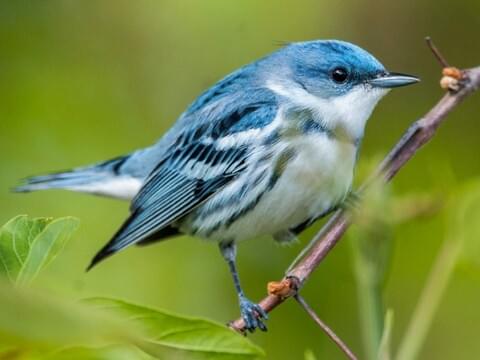Latin America
Related: About this forumA bolt from the blue: the mysterious recovery of the Cerulean Warbler
10 Oct 2019
A globally threatened bird with habitats shrinking at both ends of its migration route, the Cerulean Warbler’s population plummeted by 70% in 44 years. Now, its decline is slowing down – but why? We have a few theories…

Cerulean Warbler © Ray Hennessy / Shutterstock
By Jessica Law
We often forget how rare the colour blue is in the animal world. Mammals, for instance, can only create the pigment melanin, which restricts their coats to brown, black and reddish tones. But birds are different. They are able to capture pigments from the food they eat or, in the case of blue colouration, refract light using the internal structure of the feathers themselves. Nowhere is this more charming than in the Cerulean Warbler Setophaga cerulea, whose delicately-patterned plumage glimmers like a sapphire between the trees.
Every year, this tiny songbird makes an intrepid journey between two different types of forest within the Americas, breeding in the USA and southern Canada before migrating as far south as Bolivia. 80% of its population breeds in the Appalachian Mountains in the Eastern USA, where its high-pitched, musical call compliments (and probably inspired) the bluegrass music so famous in the region. However, the idyllic atmosphere is disturbed by mining companies removing the entire tops of mountains to access the coal reserves beneath – in the process, destroying tens of thousands of hectares of prime deciduous forest.
The freshly opened-up land also attracts the Brown-headed Cowbird Molothrus ater – a notorious brood parasite, whose cuckoo-like habit of dumping its eggs in Cerulean Warbler nests for them to raise takes a heavy toll on the population. In fact, its forest homes are shrinking at both ends due to logging, mining and the encroachment of agriculture. The precipitous decline in Cerulean Warblers (more than 70% reduction in numbers in the past 44 years) means it qualified as Vulnerable on the IUCN Red List of threatened species in 2004.
However, since 2008, the rate of decline seems to have slowed down. The science world is not quite sure of the reason behind this much-needed respite, but they have a few theories. Firstly, forest loss may also have slowed in recent years. In the USA, land protection and forest management initiatives are beginning to take notice of the species’ plight, and over a million acres of forest have been replanted with native hardwoods. Meanwhile, in South America, the first ever Cerulean Warbler Bird Reserve in Colombia is championing ‘bird-friendly’ shade-grown coffee, which allows woodland birds to thrive within plantations.
More:
http://www.birdlife.org/worldwide/news/bolt-blue-mysterious-recovery-cerulean-warbler

Science:
https://www.democraticunderground.com/122866245
secondwind
(16,903 posts)Judi Lynn
(160,527 posts)Almost too perfect!